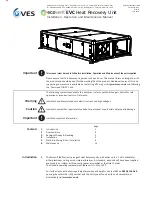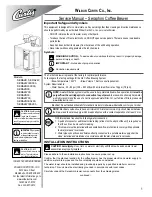
Section 1 - General Information
Electric Motors
Page 1-10
Service Manual
1-9 E
LECTRIC
M
OTORS
T
R O U B L E S H O O T I N G
Figure 1-6:
Electric Motor Service
1. Read the nameplate to become familiar with
the motor, especially the rated voltage.
2. Try to turn the shaft by hand. Keep motor
leads separated while doing this. If the shaft
turns freely go to Step 3. If the shaft won't
turn, proceed to Step A.
A. The shaft could be tight for a number of
reasons, this check is to determine if the
tightness is of a temporary nature only.
a. Obtain power to produce the nameplate
voltage. Do not Make a Permanent Con-
nection.
b. First touch the motor leads quickly to the
power supply just long enough to observe
if the shaft turns.
c. If it does turn, then hold the motor leads
on the power supply for a longer time. If
the motor sounds normal, go to Step 3..
d. If the motor sounds noisy, it should be
taken apart as described in the disassem-
bly section.
3. If the motor turned freely, connect an amme-
ter in the circuit as shown in Figure 1-6A.
With rated voltage applied and the shaft run-
ning free, the ammeter should read less
than 20% of the nameplate full load current.
If the motor meets the above conditions,
then it can be assumed that the original
problem is external to the motor.
D
I S A S S E M B L Y
1. Remove the through bolts.
2. Remove the pulley end cover.
3. Pull the armature out of the assembly in one swift motion.
4. Remove the commutator end cover.
NOTE:
Do not place the stator ring in any mechanical holding device during the disassembly or assembly operation.
Permanent distortion or other damage will result.
DC
Power
Supply
V
A
Voltage Meter
Ammeter
Brushes and
springs in their
final position
Brushes raised with
the springs in locked
position on the side
of the brush
A
B
C
Keep fingers
clear of this
space.
DC
Motor
















































